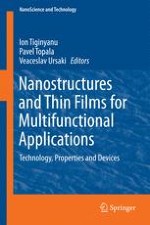This book is focused on recent advances in the development of thin films for photovoltaic applications, TiO2/WO3 bi-layers for applications with enhanced photo-catalytic properties, nanometer oxide and hydroxide films for anticorrosive coatings, surface passivation in chemical industries, micro- and nanoelectronics, trilayers of metglas and lead free piezoelectrics for magnetic field sensors, current sensors, spintronics, microwave and read/write devices. Diluted ferromagnetic alloy films are also considered for superconducting spintronics based on superconducting spin-valves. Thermal properties of segmented nanowires are analyzed with respect to thermoelectric applications. Recent advances in template production of nanocomposites are also reviewed with particular focus on technologies for template assisted formation of metal nanotubes. Some elements related to abrasive flow machining (AFM), specifically state of the art elements of technological systems and construction of equipment are presented. The book is written for researchers in materials science, nanotechnologies, PhD students and graduate student.
